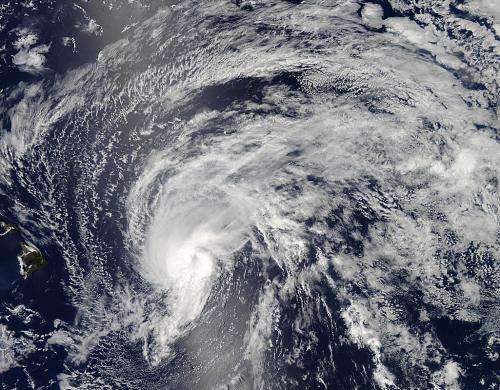NASA sees Tropical Storm Flossie near Hawaii

NASA's Aqua satellite flew over Tropical Storm Flossie as it neared Hawaii.
The Moderate Resolution Imaging Spectroradiometer or MODIS instrument that flies aboard NASA's Aqua satellite captured a visible image of Tropical Storm Flossie on July 28 at 23:10 UTC (7:10 p.m. EDT) as it continued moving toward Hawaii. The image showed that many of the thunderstorms have diminished in the storm.
On July 29, all of the Hawaiian Islands that have storm warnings have evacuation centers open. A Tropical Storm Warning is in effect for Hawaii County, Maui County including the islands of Maui, Molokai, Lanai and Kahoolawe. A warning is also in effect for Oahu. In addition, a Tropical Storm Watch is in effect for Kauai and Niihau.
The main concern is the waves associated with the high tides and flooding rains. Dangerously high surf was already pounding east facing shores of the Big Island early on July 29. Surf will continue to increase through Tuesday, July 30 and may flood roadways.
Forecasters at NOAA's Central Pacific Hurricane Center expect Flossie to produce total rainfall amounts of 6 to 10 inches over the big island and Maui County with isolated maximum amounts of 15 inches possible, mostly windward. Rainfall amounts of 4 to 8 inches are possible over Oahu with isolated maximum amounts of 12 inches possible, mostly windward.
Tropical Storm Flossie is expected to bring a lot of moisture to the leeward side of the Hawaiian Islands where the Kona coffee crops are located. That moisture will then be pushed up the mountainous terrain (orographic lift), which will go over the mountainous areas and rain on the windward side.
Flossie will be moving in the big island during the morning (local time) today, July 29.
Satellite data shows that the center of circulation is south of the strongest thunderstorms with the coldest cloud tops. Cloud top temperatures are seen on infrared imagery from the Atmospheric Infrared Sounder or AIRS instrument that also flies aboard NASA's Aqua satellite.
At 8 a.m. EDT /2 a.m. HST the Central Pacific Hurricane Center or CPHC in Honolulu, Hawaii noted that the center of Tropical Storm Flossie was located near latitude 19.6 north and longitude 152.5 west, just 165 miles (320 km) east of Hilo, Hawaii. Flossie is moving toward the west near 16 mph (28 kph) and is expected to continue for next 12 hours with a slight turn to the west northwest after that. Flossie's maximum sustained winds were near 50 mph (85 kph) and some weakening is forecast during the next 48 hours. According to CPHC, tropical storm force winds extend outward up to 100 miles (160 km) from the center.
Tropical storm conditions are expected over the big Island and Maui County today and Oahu tonight. Tropical storm conditions are possible on Kauai and Niihau tonight. Dry air aloft and northerly wind shear are expected to weaken Flossie further in the next day or two as it moves through the Hawaiian Islands.
Provided by NASA's Goddard Space Flight Center



















